A coral "group" is a colony of myriad genetically identical polyps. Each polyp is a sac-like animal typically only a few millimeters in diameter and a few centimeters in length. A set of tentacles surround a central mouth opening. An exoskeleton is excreted near the base. Over many generations, the colony thus creates a large skeleton characteristic of the species. Individual heads grow by asexual reproduction of polyps. Corals also breed sexually by spawning: polyps of the same species release gametes simultaneously over a period of one to several nights around a full moon.
Although some corals are able to catch small fish and plankton using stinging cells on their tentacles, most corals obtain the majority of their energy and nutrients from photosynthetic unicellular dinoflagellates in the genus Symbiodinium that live within their tissues. These are commonly known as zooxanthellae. Such corals require sunlight and grow in clear, shallow water, typically at depths less than 60 metres (200 ft). Corals are major contributors to the physical structure of the coral reefs that develop in tropical and subtropical waters, such as the enormous Great Barrier Reef off the coast of Queensland, Australia.
Other corals do not rely on zooxanthellae and can live in much deeper water, with the cold-water genus Lophelia surviving as deep as 3,300 metres (10,800 ft).[1] Some have been found as far north as the Darwin Mounds, northwest of Cape Wrath, Scotland, and others off the coast of Washington State and the Aleutian Islands.
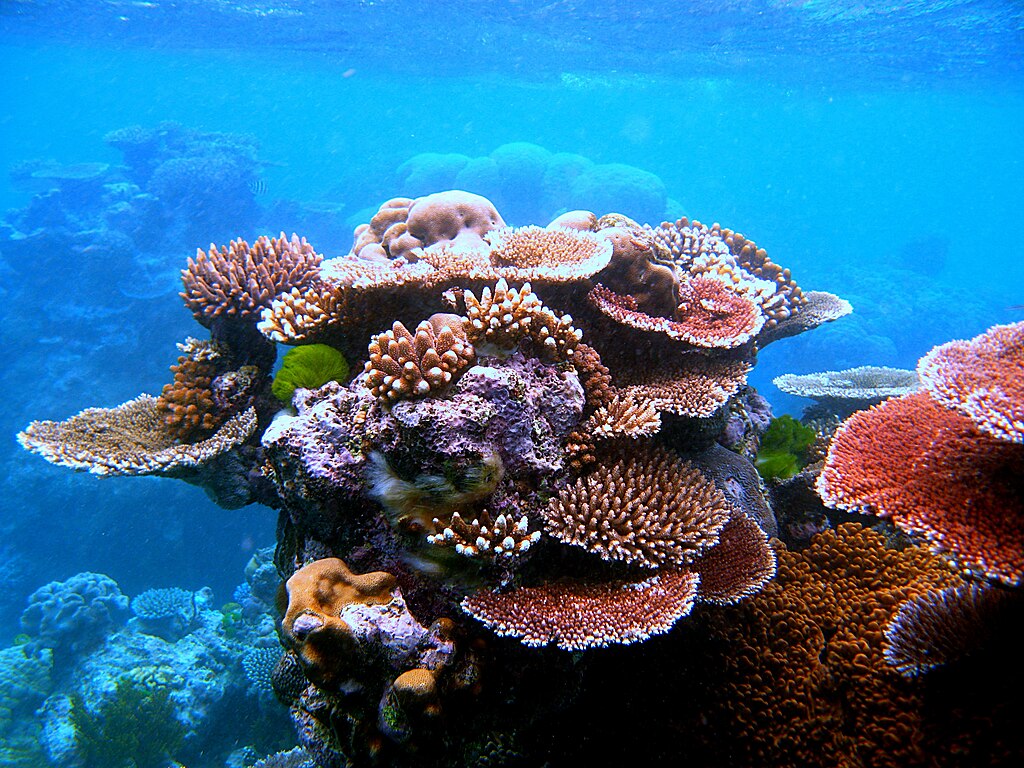
Taxonomy
Aristotle's pupil Theophrastus described the red coral, korallion, in his book on stones, implying it was a mineral, but he described it as a deep-sea plant in his Enquiries on Plants, where he also mentions large stony plants that reveal bright flowers when under water in the Gulf of Heroes.[2] Pliny the Elder stated boldly that several sea creatures including sea nettles and sponges "are neither animals nor plants, but are possessed of a third nature (tertius natura)".[3] Petrus Gyllius copied Pliny, introducing the term zoophyta for this third group in his 1535 book On the French and Latin Names of the Fishes of the Marseilles Region; it is popularly but wrongly supposed that Aristotle created the term.[3] Gyllius further noted, following Aristotle, how hard it was to define what was a plant and what was an animal.[3]The Persian polymath Al-Biruni (d. 1048) classified sponges and corals as animals, arguing that they respond to touch.[4] Nevertheless, people believed corals to be plants until the eighteenth century, when William Herschel used a microscope to establish that coral had the characteristic thin cell membranes of an animal.[5]
Presently, corals are classified as certain species of animals within the sub-classes Hexacorallia and Octocorallia of the class Anthozoa in the phylum Cnidaria.[6] Hexacorallia includes the stony corals and these groups have polyps that generally have a 6-fold symmetry. Octocorallia includes blue coral and soft corals and species of Octocorallia have polyps with an eightfold symmetry, each polyp having eight tentacles and eight mesenteries.
Fire corals are not true corals, being in the order Anthomedusae (sometimes known as Anthoathecata) of the class Hydrozoa.[7]
Anatomy
Anatomy of a stony coral polyp
Soft corals
In soft corals, there is no stony skeleton but the tissues are often toughened by the presence of tiny skeletal elements known as sclerites, which are made from calcium carbonate. Soft corals are very variable in form and most are colonial. A few soft corals are stolonate, but the polyps of most are connected by sheets of coenosarc. In some species this is thick and the polyps are deeply embedded. Some soft corals are encrusting or form lobes. Others are tree-like or whip-like and have a central axial skeleton embedded in the tissue matrix.[9] This is composed either of a fibrous protein called gorgonin or of a calcified material. In both stony and soft corals, the polyps can be retracted, with stony corals relying on their hard skeleton and cnidocytes for defence against predators, and soft corals generally relying on chemical defences in the form of toxic substances present in the tissues known as terpenoids.[8]Stony corals
Montastraea cavernosa polyps with tentacles extended
Coral skeletons are biocomposites (mineral + organics) Ca carbonate, in the form of calcite or aragonite. In scleractinian corals, "centers of calcification" and fibers are clearly distinct structures differing with respect to both morphology and chemical compositions of the crystalline units.[12][13] The organic matrices extracted from diverse species are acidic, and comprise proteins, sulphated sugars and lipids; they are species specific. [14] The soluble organic matrices of the skeletons allow to differentiate zooxanthellae and non zooxanthellae specimens.[15]
Ecology
Feeding
Polyps feed on a variety of small organisms, from microscopic zooplankton to small fish. The polyp's tentacles immobilize or kill prey using their nematocysts. These cells carry venom which they rapidly release in response to contact with another organism. A dormant nematocyst discharges in response to nearby prey touching the trigger (cnidocil). A flap (operculum) opens and its stinging apparatus fires the barb into the prey. The venom is injected through the hollow filament to immobilise the prey; the tentacles then manoeuvre the prey to the mouth.[16][17]The tentacles then contract to bring the prey into the stomach. Once the prey is digested, the stomach reopens, allowing the elimination of waste products and the beginning of the next hunting cycle. They can scavenge drifting organic molecules and dissolved organic molecules.[18]:24
Intracellular symbionts
Many corals, as well as other cnidarian groups such as Aiptasia (a sea anemone) form a symbiotic relationship with a class of dinoflagellate algae, zooxanthellae of the genus Symbiodinium.[18]:24 Aiptasia, a familiar pest among coral reef aquarium hobbyists, serves as a valuable model organism in the study of cnidarian-algal symbiosis.[19] Typically, each polyp harbors one species of alga, and coral species show a preference for Symbiodinium.[20] Young corals are not born with zooxanthellae, but acquire the algae from the surrounding environment, including the water column and local sediment.[21] Via photosynthesis, these provide energy for the coral, and aid in calcification.[22] The main benefit of the zooxanthellae is their ability to photosynthesize. By using this technique, zooxanthellae are able to supply corals with the products of photosynthesis, including glucose, glycerol, and amino acids, which the corals can use for energy.[23] As much as 30% of the tissue of a polyp may be algal material.[18]:23 Zooxanthellae also benefit corals by aiding in waste removal.[24] In addition to the soft tissue, microbiomes are also found in the coral's mucus and (in stony corals) the skeleton, with the latter showing the greatest microbial richness.[25]The algae benefit from a safe place to live and consume the polyp's carbon dioxide and nitrogenous waste. Due to the strain the algae can put on the polyp, stress on the coral often drives them to eject the algae. Mass ejections are known as coral bleaching, because the algae contribute to coral's brown coloration; other colors, however, are due to host coral pigments, such as green fluorescent proteins (GFPs). Ejection increases the polyp's chance of surviving short-term stress—they can regain algae, possibly of a different species at a later time. If the stressful conditions persist, the polyp eventually dies.[26] Zooxanthellae are located within the corals' cytoplasm and due to the algae's photosynthetic activity, the internal pH of the coral can be raised; this behavior indicates that the zooxanthellae are responsible to some extent for the metabolism of their host corals [27]
Reproduction
Corals can be both gonochoristic (unisexual) and hermaphroditic, each of which can reproduce sexually and asexually. Reproduction also allows coral to settle in new areas. Reproduction is coordinated by chemical communication.Sexual
Life cycles of broadcasters and brooders
Broadcasters
About 75% of all hermatypic corals "broadcast spawn" by releasing gametes—eggs and sperm—into the water to spread offspring. The gametes fuse during fertilization to form a microscopic larva called a planula, typically pink and elliptical in shape. A typical coral colony forms several thousand larvae per year to overcome the odds against formation of a new colony.[29]
A male great star coral, Montastraea cavernosa, releasing sperm into the water.
Brooders
Brooding species are most often ahermatypic (not reef-building) in areas of high current or wave action. Brooders release only sperm, which is negatively buoyant, sinking on to the waiting egg carriers who harbor unfertilized eggs for weeks. Synchronous spawning events sometimes occur even with these species.[28] After fertilization, the corals release planula that are ready to settle.[22]
Generalized life cycle of corals via sexual reproduction.
Planulae
Planula larvae exhibit positive phototaxis, swimming towards light to reach surface waters, where they drift and grow before descending to seek a hard surface to which they can attach and begin a new colony. They also exhibit positive sonotaxis, moving towards sounds that emanate from the reef and away from open water.[31] High failure rates afflict many stages of this process, and even though millions of gametes are released by each colony, few new colonies form. The time from spawning to settling is usually two to three days, but can be up to two months.[32] The larva grows into a polyp and eventually becomes a coral head by asexual budding and growth.Asexual
Basal plates (calices) of Orbicella annularis showing multiplication by budding (small central plate) and division (large double plate)
Budding involves splitting a smaller polyp from an adult.[29] As the new polyp grows, it forms its body parts. The distance between the new and adult polyps grows, and with it, the coenosarc (the common body of the colony). Budding can be intratentacular, from its oral discs, producing same-sized polyps within the ring of tentacles, or extratentacular, from its base, producing a smaller polyp.
Division forms two polyps that each become as large as the original. Longitudinal division begins when a polyp broadens and then divides its coelenteron (body), effectively splitting along its length. The mouth divides and new tentacles form. The two polyps thus created then generate their missing body parts and exoskeleton. Transversal division occurs when polyps and the exoskeleton divide transversally into two parts. This means one has the basal disc (bottom) and the other has the oral disc (top); the new polyps must separately generate the missing pieces.
Asexual reproduction offers the benefits of high reproductive rate, delaying senescence, and replacement of dead modules, as well as geographical distribution.[33]
Colony division
Whole colonies can reproduce asexually, forming two colonies with the same genotype. The possible mechanisms include fission, bailout and fragmentation. Fission occurs in some corals, especially among the family Fungiidae, where the colony splits into two or more colonies during early developmental stages. Bailout occurs when a single polyp abandons the colony and settles on a different substrate to create a new colony. Fragmentation involves individuals broken from the colony during storms or other disruptions. The separated individuals can start new colonies.[34]Reefs

Locations of coral reefs around the world
Staghorn coral (Acropora cervicornis) is an important hermatypic coral from the Caribbean
Evolutionary history
Solitary rugose coral (Grewingkia) in three views; Ordovician, southeastern Indiana
Tabulate coral (a syringoporid); Boone limestone (Lower Carboniferous) near Hiwasse, Arkansas, scale bar is 2.0 cm
Rugose or horn corals became dominant by the middle of the Silurian period, and became extinct early in the Triassic period. The rugose corals existed in solitary and colonial forms, and were also composed of calcite.[42]
The scleractinian corals filled the niche vacated by the extinct rugose and tabulate species. Their fossils may be found in small numbers in rocks from the Triassic period, and became common in the Jurassic and later periods.[43] Scleractinian skeletons are composed of a form of calcium carbonate known as aragonite.[44] Although they are geologically younger than the tabulate and rugose corals, the aragonite of their skeletons is less readily preserved, and their fossil record is accordingly less complete.
 | |
|
Timeline of the major coral fossil record and developments from 650 m.y.a. to present.[45][46]
|
|
Status
Threats
A healthy coral reef has a striking level of biodiversity in many forms of marine life.
Approximately 10% of the world's coral reefs are dead.[51][52][53] About 60% of the world's reefs are at risk due to human-related activities.[54] The threat to reef health is particularly strong in Southeast Asia, where 80% of reefs are endangered.[55] Over 50% of the world's coral reefs may be destroyed by 2030; as a result, most nations protect them through environmental laws.[56]
In the Caribbean and tropical Pacific, direct contact between ~40–70% of common seaweeds and coral causes bleaching and death to the coral via transfer of lipid-soluble metabolites.[57] Seaweed and algae proliferate given adequate nutrients and limited grazing by herbivores such as parrotfish.
Water temperature changes of more than 1–2 °C (1.8–3.6 °F) or salinity changes can kill some species of coral. Under such environmental stresses, corals expel their Symbiodinium; without them coral tissues reveal the white of their skeletons, an event known as coral bleaching.[58]
Submarine springs found along the coast of Mexico's Yucatán Peninsula produce water with a naturally low pH (relatively high acidity) providing conditions similar to those expected to become widespread as the oceans absorb carbon dioxide.[59] Surveys discovered multiple species of live coral that appeared to tolerate the acidity. The colonies were small and patchily distributed, and had not formed structurally complex reefs such as those that compose the nearby Mesoamerican Barrier Reef System.[59]
Protection
Marine Protected Areas, Biosphere reserves, marine parks, national monuments world heritage status, fishery management and habitat protection can protect reefs from anthropogenic damage.[60]Many governments now prohibit removal of coral from reefs, and inform coastal residents about reef protection and ecology. While local action such as habitat restoration and herbivore protection can reduce local damage, the longer-term threats of acidification, temperature change and sea-level rise remain a challenge.[49]
To eliminate destruction of corals in their indigenous regions, projects have been started to grow corals in non-tropical countries.[61][62]
Relation to humans
Local economies near major coral reefs benefit from an abundance of fish and other marine creatures as a food source. Reefs also provide recreational scuba diving and snorkeling tourism. These activities can damage coral but international projects such as Green Fins that encourage dive and snorkel centres to follow a Code of Conduct have been proven to mitigate these risks.[63]Jewelry
6-strand necklace, Navajo (Native American), ca. 1920s, Brooklyn Museum
Always considered a precious mineral, "the Chinese have long associated red coral with auspiciousness and longevity because of its color and its resemblance to deer antlers (so by association, virtue, long life, and high rank".[65] It reached its height of popularity during the Manchu or Qing Dynasty (1644-1911) when it was almost exclusively reserved for the emperor's use either in the form of coral beads (often combined with pearls) for court jewelry or as decorative Penjing (decorative miniature mineral trees). Coral was known as shanhu in Chinese. The "early-modern 'coral network' [began in] the Mediterranean Sea [and found its way] to Qing China via the English East India Company".[66] There were strict rules regarding its use in a code established by the Qianlong Emperor in 1759.
Medicine
Depiction of coral in the Juliana Anicia Codex, a 6th-century copy of Dioscorides' De Materia Medica. The facing page states that coral can be used to treat ulcers.[67]
Construction
Coral reefs in places such as the East African coast are used as a source of building material.[73] Ancient (fossil) coral limestone, notably including the Coral Rag Formation of the hills around Oxford (England), was once used as a building stone, and can be seen in some of the oldest buildings in that city including the Saxon tower of St Michael at the Northgate, St. George's Tower of Oxford Castle, and the medieval walls of the city.[74]Shoreline protection
Healthy coral reefs absorb 97 percent of a wave’s energy, which buffers shorelines from currents, waves, and storms, helping to prevent loss of life and property damage. Coastlines protected by coral reefs are also more stable in terms of erosion than those without.[75]Local Economies
Coastal communities near coral reefs rely heavily on them. Worldwide, more than 500 million people depend on coral reefs for food, income, coastal protection, and more.[76] The total economic value of coral reef services in the United States - including fisheries, tourism, and coastal protection - is more than $3.4 billion a year.Climate research
Annual growth bands in some corals, such as the deep sea bamboo corals (Isididae), may be among the first signs of the effects of ocean acidification on marine life.[77] The growth rings allow geologists to construct year-by-year chronologies, a form of incremental dating, which underlie high-resolution records of past climatic and environmental changes using geochemical techniques.[78]Certain species form communities called microatolls, which are colonies whose top is dead and mostly above the water line, but whose perimeter is mostly submerged and alive. Average tide level limits their height. By analyzing the various growth morphologies, microatolls offer a low resolution record of sea level change. Fossilized microatolls can also be dated using Radiocarbon dating. Such methods can help to reconstruct Holocene sea levels.[79]
Increasing sea temperatures in tropical regions (~1 degree C) the last century have caused major coral bleaching, death, and therefore shrinking coral populations since although they are able to adapt and acclimate, it is uncertain if this evolutionary process will happen quickly enough to prevent major reduction of their numbers.[80]
Though coral have large sexually-reproducing populations, their evolution can be slowed by abundant asexual reproduction.[81] Gene flow is variable among coral species.[81] According to the biogeography of coral species gene flow cannot be counted on as a dependable source of adaptation as they are very stationary organisms. Also, coral longevity might factor into their adaptivity.[81]
However, adaptation to climate change has been demonstrated in many cases. These are usually due to a shift in coral and zooxanthellae genotypes. These shifts in allele frequency have progressed toward more tolerant types of zooxanthellae.[82] Scientists found that a certain scleractinian zooxanthella is becoming more common where sea temperature is high.[83][84] Symbionts able to tolerate warmer water seem to photosynthesise more slowly, implying an evolutionary trade-off.[84]
In the Gulf of Mexico, where sea temperatures are rising, cold-sensitive staghorn and elkhorn coral have shifted in location.[82] Not only have the symbionts and specific species been shown to shift, but there seems to be a certain growth rate favorable to selection. Slower-growing but more heat-tolerant corals have become more common.[85] The changes in temperature and acclimation are complex. Some reefs in current shadows represent a refugium location that will help them adjust to the disparity in the environment even if eventually the temperatures may rise more quickly there than in other locations.[86] This separation of populations by climatic barriers causes a realized niche to shrink greatly in comparison to the old fundamental niche.
Geochemistry
Corals are shallow, colonial organisms that integrate δ18O and trace elements into their skeletal aragonite (polymorph of calcite) crystalline structures, as they grow. Geochemistry anomalies within the crystalline structures of corals represent functions of temperature, salinity and oxygen isotopic composition. Such geochemical analysis can help with climate modeling.[87]Strontium/calcium ratio anomaly
Time can be attributed to coral geochemistry anomalies by correlating strontium/calcium minimums with sea surface temperature (SST) maximums to data collected from NINO 3.4 SSTA.[88]Oxygen isotope anomaly
The comparison of coral strontium/calcium minimums with sea surface temperature maximums, data recorded from NINO 3.4 SSTA, time can be correlated to coral strontium/calcium and δ18O variations. To confirm accuracy of the annual relationship between Sr/Ca and δ18O variations, a perceptible association to annual coral growth rings confirms the age conversion. Geochronology is established by the blending of Sr/Ca data, growth rings, and stable isotope data. El Nino-Southern Oscillation (ENSO) is directly related to climate fluctuations that influence coral δ18O ratio from local salinity variations associated with the position of the South Pacific convergence zone (SPCZ) and can be used for ENSO modeling.[88]Sea surface temperature and sea surface salinity
Global sea surface temperature (SST)
Geochemical analysis of skeletal coral can be linked to sea surface salinity (SSS) and sea surface temperature (SST), from El Nino 3.4 SSTA data, of tropical oceans to seawater δ18O ratio anomalies from corals. ENSO phenomenon can be related to variations in sea surface salinity (SSS) and sea surface temperature (SST) that can help model tropical climate activities.[91]
Limited climate research on current species
Porites lutea
Aquaria
This dragon-eye zoanthid is a popular source of color in reef tanks
The most popular kind of coral kept is soft coral, especially zoanthids and mushroom corals, which are especially easy to grow and propagate in a wide variety of conditions, because they originate in enclosed parts of reefs where water conditions vary and lighting may be less reliable and direct.[95] More serious fishkeepers may keep small polyp stony coral, which is from open, brightly lit reef conditions and therefore much more demanding, while large polyp stony coral is a sort of compromise between the two.
Aquaculture
Coral aquaculture, also known as coral farming or coral gardening, is the cultivation of corals for commercial purposes or coral reef restoration. Aquaculture is showing promise as a potentially effective tool for restoring coral reefs, which have been declining around the world.[96][97][98] The process bypasses the early growth stages of corals when they are most at risk of dying. Coral fragments known as "seeds" are grown in nurseries then replanted on the reef.[99] Coral is farmed by coral farmers who live locally to the reefs and farm for reef conservation or for income. It is also farmed by scientists for research, by businesses for the supply of the live and ornamental coral trade and by private aquarium hobbyists.Gallery
Further images: commons:Category:Coral reefs and commons:Category:Corals- Fungia sp. skeleton
- Polyps of Eusmilia fastigiata
- Pillar coral, Dendrogyra cylindricus
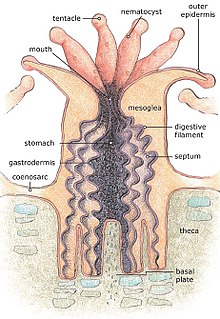




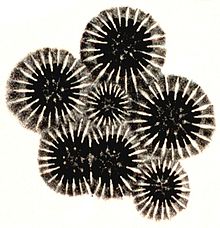






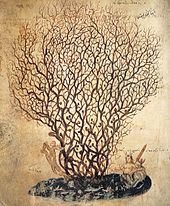
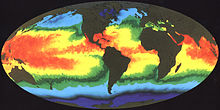



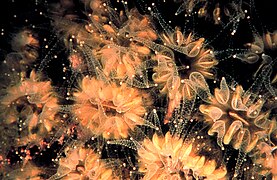





No comments:
Post a Comment
Note: Only a member of this blog may post a comment.